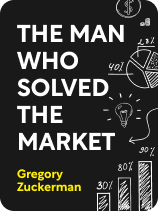

This article is an excerpt from the Shortform book guide to "The Man Who Solved the Market" by Gregory Zuckerman. Shortform has the world's best summaries and analyses of books you should be reading.
Like this article? Sign up for a free trial here.
What is Jim Simons’s educational background? Where did Simons study before he became a billionaire money manager?
Before he used mathematical models to dominate the market and become a billionaire, Jim Simons was just a student interested in math. The Man Who Solved the Market by Gregory Zuckerman details his educational background before his stellar financial career.
Find out more about Jim Simons’s education and how he discovered investing.
An Intellectual Pursuit
As a student, writes Zuckerman, Jim Simons’s education mostly revolved around mathematics, purely as an intellectual pursuit. He was motivated by the challenge of solving problems, the thrill of new discoveries, and the exploration of unsolved mysteries. At this age, he had little interest in—or conception of—the application of mathematics to the “real” world or how he could harness it for personal financial gain. Although money and wealth had a certain allure to Simons as a young man, mathematics for its own sake was his abiding passion.
| Pure vs. Applied Mathematics Simons’s passion for math as an intellectual pursuit speaks to a broader division within the field of mathematics—that between pure mathematics and applied mathematics. Pure mathematics is focused on theory—people who engage in pure mathematics work with abstract concepts and theorems. An inquiry-based discipline, pure mathematics seeks to prove theorems or find solutions for unsolved problems, such as the Millennium Prize Problems selected by the Clay Mathematics Institute (solving any one of them can earn a mathematician a $1 million prize from the Institute). Applied mathematics, meanwhile, is about the practical use of those concepts and theorems to solve real-world problems. Applied mathematics employs these concepts in fields from science, to economics, accounting, medicine, and, as we’ll see in Simons’s case, investing. |
Discovering Investing
Zuckerman writes that Simons began to discover the exhilaration and thrill of investing in his early 20s. While completing his doctoral program at the University of California, Berkeley, he made a few preliminary trades by investing in soybean futures.
After earning some initial profits when the price of soybeans skyrocketed, Simons—ignoring a friend’s advice about the volatility of commodities prices—held onto his investment too long and saw his profits evaporate when soybean prices tumbled. But the experience was his first entry into the world of investing that would later define his life—and make his fortune.
| Understanding Futures Contracts To understand Simons’s early investing experience, it’s worthwhile to examine exactly what a commodity futures contract is and how it works. Essentially, a commodity futures contract is an agreement to buy or sell commodities—in Simons’s case, soybeans—at a specific price on a specified future date. Such contracts enable buyers and sellers to hedge against future price swings for agricultural commodities or other commodities like oil, gold, or silver, which are notoriously volatile. For example, if a soybean farmer’s break-even point (where they make back the money they spent to produce something) on a bushel of soybeans is $20/bushel, she may agree to sell a one-year soybean futures contract for $30/barrel. This obliges the buyer of that contract to purchase the farmer’s soybeans at $30/barrel in one year—regardless of what the market price for soybeans is at that time. In this scenario, the farmer is betting that the market price for soybeans will be below $30/barrel and she’ll be able to lock in an above-market price for her soybeans. The buyer, meanwhile, is betting that soybeans will rise above $30/barrel in one year, and she’ll be able to lock in a below-market price for them. In Simons’s case, he was on the losing end of such a transaction: He purchased soybean futures contracts that obliged him to overpay for soybeans when the price for them dropped. |

———End of Preview———
Like what you just read? Read the rest of the world's best book summary and analysis of Gregory Zuckerman's "The Man Who Solved the Market" at Shortform.
Here's what you'll find in our full The Man Who Solved the Market summary:
- The story of Jim Simons, one of the most successful hedge fund managers ever
- How Simons' experience as a codebreaker helped him succeed
- How Simons set the stage for today's large-scale, automated trading






